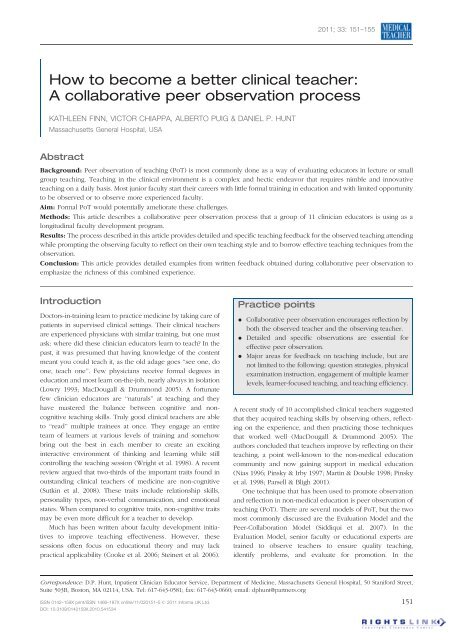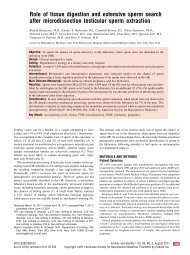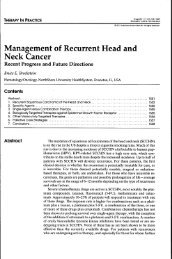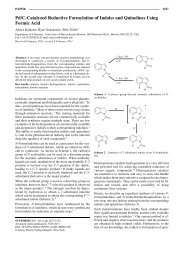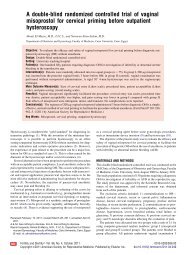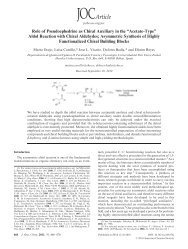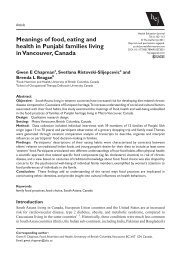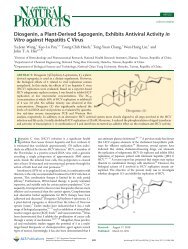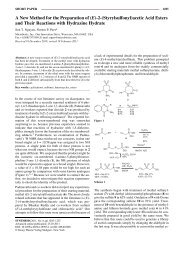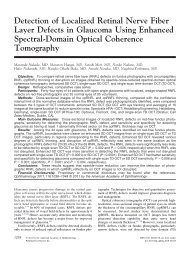A collaborative peer observation process
A collaborative peer observation process
A collaborative peer observation process
You also want an ePaper? Increase the reach of your titles
YUMPU automatically turns print PDFs into web optimized ePapers that Google loves.
2011; 33: 151–155<br />
How to become a better clinical teacher:<br />
A <strong>collaborative</strong> <strong>peer</strong> <strong>observation</strong> <strong>process</strong><br />
KATHLEEN FINN, VICTOR CHIAPPA, ALBERTO PUIG & DANIEL P. HUNT<br />
Massachusetts General Hospital, USA<br />
Abstract<br />
Background: Peer <strong>observation</strong> of teaching (PoT) is most commonly done as a way of evaluating educators in lecture or small<br />
group teaching. Teaching in the clinical environment is a complex and hectic endeavor that requires nimble and innovative<br />
teaching on a daily basis. Most junior faculty start their careers with little formal training in education and with limited opportunity<br />
to be observed or to observe more experienced faculty.<br />
Aim: Formal PoT would potentially ameliorate these challenges.<br />
Methods: This article describes a <strong>collaborative</strong> <strong>peer</strong> <strong>observation</strong> <strong>process</strong> that a group of 11 clinician educators is using as a<br />
longitudinal faculty development program.<br />
Results: The <strong>process</strong> described in this article provides detailed and specific teaching feedback for the observed teaching attending<br />
while prompting the observing faculty to reflect on their own teaching style and to borrow effective teaching techniques from the<br />
<strong>observation</strong>.<br />
Conclusion: This article provides detailed examples from written feedback obtained during <strong>collaborative</strong> <strong>peer</strong> <strong>observation</strong> to<br />
emphasize the richness of this combined experience.<br />
Introduction<br />
Doctors-in-training learn to practice medicine by taking care of<br />
patients in supervised clinical settings. Their clinical teachers<br />
are experienced physicians with similar training, but one must<br />
ask: where did these clinician educators learn to teach? In the<br />
past, it was presumed that having knowledge of the content<br />
meant you could teach it, as the old adage goes ‘‘see one, do<br />
one, teach one’’. Few physicians receive formal degrees in<br />
education and most learn on-the-job, nearly always in isolation<br />
(Lowry 1993; MacDougall & Drummond 2005). A fortunate<br />
few clinician educators are ‘‘naturals’’ at teaching and they<br />
have mastered the balance between cognitive and noncognitive<br />
teaching skills. Truly good clinical teachers are able<br />
to ‘‘read’’ multiple trainees at once. They engage an entire<br />
team of learners at various levels of training and somehow<br />
bring out the best in each member to create an exciting<br />
interactive environment of thinking and learning while still<br />
controlling the teaching session (Wright et al. 1998). A recent<br />
review argued that two-thirds of the important traits found in<br />
outstanding clinical teachers of medicine are non-cognitive<br />
(Sutkin et al. 2008). These traits include relationship skills,<br />
personality types, non-verbal communication, and emotional<br />
states. When compared to cognitive traits, non-cognitive traits<br />
may be even more difficult for a teacher to develop.<br />
Much has been written about faculty development initiatives<br />
to improve teaching effectiveness. However, these<br />
sessions often focus on educational theory and may lack<br />
practical applicability (Cooke et al. 2006; Steinert et al. 2006).<br />
Practice points<br />
. Collaborative <strong>peer</strong> <strong>observation</strong> encourages reflection by<br />
both the observed teacher and the observing teacher.<br />
. Detailed and specific <strong>observation</strong>s are essential for<br />
effective <strong>peer</strong> <strong>observation</strong>.<br />
. Major areas for feedback on teaching include, but are<br />
not limited to the following: question strategies, physical<br />
examination instruction, engagement of multiple learner<br />
levels, learner-focused teaching, and teaching efficiency.<br />
A recent study of 10 accomplished clinical teachers suggested<br />
that they acquired teaching skills by observing others, reflecting<br />
on the experience, and then practicing those techniques<br />
that worked well (MacDougall & Drummond 2005). The<br />
authors concluded that teachers improve by reflecting on their<br />
teaching, a point well-known to the non-medical education<br />
community and now gaining support in medical education<br />
(Nias 1996; Pinsky & Irby 1997; Martin & Double 1998; Pinsky<br />
et al. 1998; Parsell & Bligh 2001).<br />
One technique that has been used to promote <strong>observation</strong><br />
and reflection in non-medical education is <strong>peer</strong> <strong>observation</strong> of<br />
teaching (PoT). There are several models of PoT, but the two<br />
most commonly discussed are the Evaluation Model and the<br />
Peer-Collaboration Model (Siddiqui et al. 2007). In the<br />
Evaluation Model, senior faculty or educational experts are<br />
trained to observe teachers to ensure quality teaching,<br />
identify problems, and evaluate for promotion. In the<br />
Correspondence: D.P. Hunt, Inpatient Clinician Educator Service, Department of Medicine, Massachusetts General Hospital, 50 Staniford Street,<br />
Suite 503B, Boston, MA 02114, USA. Tel: 617-643-0581; fax: 617-643-0660; email: dphunt@partners.org<br />
ISSN 0142–159X print/ISSN 1466–187X online/11/020151–5 ß 2011 Informa UK Ltd. 151<br />
DOI: 10.3109/0142159X.2010.541534
K. Finn et al.<br />
Peer-Collaboration Model co-teachers observe each other to<br />
create a discussion about teaching through mutual reflection.<br />
PoT is not a new idea to clinical medicine. Irby published a<br />
PoT study in 1983 and several articles involving PoT have been<br />
written since then (Irby 1983a, b; Horowitz et al. 1998; Snell<br />
et al. 2000; Beckman et al. 2003). However, these studies<br />
employed the Evaluation Model using multi-itemed check-lists<br />
with Likert-scales and trained observers to assess teachers’<br />
skills. This type of PoT has not been widely adopted by the<br />
academic medicine community, possibly because its evaluative<br />
nature is not conducive to personal teaching development. It is<br />
not clear that an evaluative and grading <strong>process</strong> would provide<br />
a safe environment for the key elements of reflection and<br />
feedback (Nias 1996; MacDougall & Drummond 2005).<br />
In addition, it is difficult to interpret the meaning of a score<br />
on a Likert-scale for any particular teaching technique or skill<br />
and then improve on it. Finally, the observer of the <strong>process</strong><br />
must focus on a checklist rather than the <strong>observation</strong> itself and<br />
thereby miss his or her own opportunity for learning. The<br />
natural <strong>observation</strong>s and reflections of the observer may be<br />
the key benefits of PoT in developing both the observer and the<br />
observed teacher. Beckman suggested this after 100 personhours<br />
of direct <strong>observation</strong> on bedside teaching (Beckman<br />
2004). He found that direct <strong>observation</strong> ranked among his most<br />
influential educational experiences. He recognized the difficulty<br />
in detaching oneself from the medicine content to focus<br />
on teaching and that by doing so a myriad of new teaching<br />
styles and techniques exposed themselves. Observing a <strong>peer</strong><br />
teach will create self-comparison and thereby lead to reflection.<br />
A clinician educator’s training, background, and prior experiences<br />
will consciously and unconsciously shape what he or she<br />
is capable of seeing (Eva & Regehr 2008).<br />
Previous reports of PoT in the clinical teaching environment<br />
are limited to short-term <strong>observation</strong>s designed to<br />
determine the characteristics of outstanding teachers (Irby<br />
1983b; Irby 1992; Beckman 2004) or to provide formal<br />
evaluation of teachers. As a newly formed group of clinician<br />
educators, we decided to use PoT as a longitudinal faculty<br />
development project that encouraged <strong>observation</strong>s by and for<br />
each member of the group. This project is now in its fifth year<br />
and affords an opportunity for reflection on PoT as a faculty<br />
development tool. Our faculty group has now grown to 11<br />
clinician-educators. In addition, as our experience has grown,<br />
we have provided <strong>peer</strong> <strong>observation</strong> for novice (Chief Resident)<br />
and very experienced clinical teachers (more than 35 years of<br />
experience) outside our group. We will describe the <strong>process</strong> in<br />
detail and then comment on specific <strong>observation</strong>s drawn from<br />
more than 40 written narratives completed after each <strong>peer</strong><br />
<strong>observation</strong>.<br />
The <strong>peer</strong> <strong>observation</strong> <strong>process</strong><br />
Peer <strong>observation</strong>s occur during routine attending rounds on an<br />
inpatient ward service. The ward team typically consists of 2<br />
attending physicians (‘‘co-attendings’’), 1 or 2 junior residents,<br />
4 interns, and 1–3 medical students who care for 18–24<br />
patients on a medicine ward. During the daily 2 h attending-led<br />
teaching rounds, the team generally focuses on the presentation<br />
and discussion of newly admitted patients, ranging from 1<br />
152<br />
to 10 in number. The <strong>peer</strong> observer is a clinician-educator who<br />
is off-service at the time of the <strong>observation</strong>. There is no formal<br />
training of the observer or detailed check-list used during the<br />
<strong>observation</strong> as the intent is to capture the essence of teaching<br />
rounds in their ‘‘natural state’’. However, general areas for<br />
<strong>observation</strong> are suggested: observers are asked to ignore the<br />
clinical content and note areas, such as team dynamics,<br />
bedside teaching techniques, teaching moments, feedback<br />
given, and specific teaching styles and techniques used. The<br />
observer is encouraged to comment on time management,<br />
overall engagement of the team in the discussion of patients,<br />
and non-cognitive aspects of teaching. In addition, the<br />
observer and observed faculty do discuss beforehand if there<br />
is anything specific for which the faculty being observed<br />
desires feedback.<br />
Peer observers join the team at the beginning of rounds and<br />
introduce themselves and their purpose to all team members.<br />
The observer makes it clear that he is not present to evaluate<br />
residents or students on the team, but simply to focus on<br />
observing the teaching methods and techniques employed by<br />
the attending staff. Following introductions, the <strong>peer</strong> observer<br />
remains silent and in the background for the remainder of<br />
rounds, taking notes on teaching, but not contributing to the<br />
clinical or didactic discussion. Observations occur during all<br />
aspects or activities of attending rounds, including conference<br />
room discussions, hallway team discussions, and bedside<br />
encounters.<br />
Shortly after the <strong>observation</strong> session, the observer provides<br />
verbal feedback to the observed attending. This session<br />
generally takes the form of recounting specific examples<br />
from rounds that represent teaching skills and techniques that<br />
were perceived as effective as well as offering alternative<br />
methods and potential opportunities for improvement.<br />
Following verbal feedback, the observer writes a narrative,<br />
structured summary of the experience using the outline in<br />
Table 1. Written comments are provided to the observed<br />
attending and all reports are placed in a shared drive<br />
accessible to all faculty who participate. These can be<br />
Table 1. Basic template for written summary of <strong>peer</strong> <strong>observation</strong>.<br />
Major topic Specific components<br />
1. Identifying data Observer<br />
Who is being observed (attending)<br />
Setting (team, ward)<br />
Date<br />
2. Overall environment Describe tone and atmosphere<br />
Number of patients presented and timing<br />
3. Cases presented One or two sentences to describe the case,<br />
who presented it and where.<br />
Observations on:<br />
A. Teaching moments and techniques used<br />
B. Feedback given and when<br />
C. Suggestions of alternative ways to make<br />
teaching points, structure the discussion, or<br />
organize bedside rounds. Mention of other<br />
possible teaching points that could have been<br />
made with the caveat that time is limited<br />
Final points What worked well and suggestions for alternative<br />
ways to approach teaching during the<br />
observed rounds
eferenced for educational purposes and serve as permanent<br />
documentation of the groups’ commitment to faculty<br />
development.<br />
Analysis of the <strong>peer</strong> <strong>observation</strong> <strong>process</strong><br />
In order to better understand the potential impact of this type<br />
of PoT as a faculty development <strong>process</strong>, two of the authors<br />
(VC and KF) independently reviewed all available written<br />
narratives in order to identify common themes in the reports of<br />
<strong>observation</strong>s. Through content analysis, the top five major<br />
Table 2. Examples from written feedback following <strong>peer</strong> <strong>observation</strong>.<br />
Teaching issue Examples<br />
areas that proved to be critical to effective clinical teaching<br />
were identified: question strategies, physical examination<br />
instruction, engagement of multiple learner levels, learnerfocused<br />
teaching, and teaching efficiency (time management).<br />
Disagreements on selection of these areas were resolved<br />
through consensus and with input from a third author (DH)<br />
(Thomas 2006). Table 2 provides verbatim examples in each of<br />
these areas drawn from the written narratives in order to<br />
provide an understanding of the level of detail in <strong>observation</strong><br />
and feedback that we have found most effective for teaching<br />
development.<br />
Question strategies A patient was admitted with a marked hyperosmolar state (Na 147, glucose 800’s). The attending asked ‘‘What is the<br />
normal blood volume?’’ After a pause, she quickly supplied her own answer and moved on. This effectively cut off a<br />
learning topic. Instead this could have been addressed by asking ‘Where is volume stored in the body?’ and drawing<br />
a diagram of the various compartments. This analysis would give the learner a broader view than a simple fact about<br />
blood volume.’’<br />
An 80-year-old woman with lytic changes in her vertebral body was admitted with leg weakness. The observer wrote:<br />
‘‘The attending used a great teaching technique in the discussion by asking two hypothetical questions. ‘If this patient<br />
had a cord compression from her vertebral lesion, what would you do?’ This is excellent. The hypothetical must be a<br />
plausible scenario for the presented patient and in this case it clearly was. The second question was, ‘If this patient had<br />
an epidural abscess and cord compression would you give her steroids?’ This is not as directly tied to the thinking about<br />
the patient herself, but is close enough to still engage. Good discussion followed, including a brief polling of opinions.’’<br />
Physical examination<br />
instruction<br />
Engagement of multiple<br />
learner levels<br />
‘‘Four stethoscopes were placed on the chest simultaneously. Perfectly fine, but the key component is to ask, ‘What did<br />
you hear?’ beginning with the student. This did not occur at the bedside. Hallway discussion indicated a systolic<br />
murmur. No way to know if everyone heard it unless the inquiry occurred at the bedside when the learners could relisten.’’<br />
‘‘The attending led the exam. Excellent in that she asked the co-examiner for findings, ‘‘Do you guys hear anything?’’<br />
Might alter this slight to ‘‘What do you hear?’’ as this more neutral question forces the learner to take a stand even if it is<br />
normal, instead of a question that might imply that the attending didn’t hear anything abnormal and would tend to damp<br />
down the learner response if they had heard abnormality.’’<br />
‘‘An intern presented an 89 year old patient with peri-aortic lymphadenopathy and a vertebral body lytic lesion. After<br />
returning to the hallway, the intern gave his differential diagnosis, explained his thinking and plans for next step. The<br />
attending praised the intern with ‘‘I have nothing to add.’’ The observer commended the positive reinforcement to the<br />
intern about a job well done, but noted ‘‘the discussion of problems focused solely on the admitting intern. This left<br />
the three interns contributing nothing to the discussion. This is difficult as one wants to allow the admitting intern to<br />
demonstrate his or her thinking. However, one might approach this in the following manner: Say to the admitting<br />
intern, ‘I realize you’ve had a chance to think about the patient overnight, but I’d like to first obtain the thoughts of the<br />
team.’ Get the team involved in a discussion and then return to the admitting intern with ‘How did we do or was this<br />
how you put it together?’ The intern can expand if he wants and is still allowed to shine.’’<br />
‘‘An elderly woman was admitted with cough and shortness of breath and suspected congestive heart failure (CHF).<br />
Although the history and case presentation were consistent with a presumed diagnosis of CHF, the physical exam and<br />
further questioning of the patient did not support this. The attending invited the team to re-evaluate the current situation<br />
by asking, ‘Does this lady look like she is in heart failure?’ He moved up the ladder, starting with the students, then interns<br />
and then resident to get their opinions. Each team member had to ‘‘put their money down’’ and no one was singled out.<br />
This received attention from all team members and became a great chance for the whole team to engage in the<br />
discussion and presentation of heart failure.’’<br />
Learner-focused teaching ‘‘Overall the tone of rounds was relaxed. The interns, resident and medical student appeared comfortable with asking<br />
questions during the discussion. The post-call intern was given the stage without interruption and visibly grew more<br />
confident during rounds as WC checked in with him at each bedside encounter asking, ‘Was there anything else you<br />
wanted us to check?’ This was a great teaching technique for it showed respect for the intern for all the work he did<br />
overnight and acknowledged that the team was following his lead.’’<br />
‘‘While examining a complex patient with peripheral vascular disease, one of the sub-interns noted a rash on the patient’s<br />
legs and inquired about the rash. The attending halted the other conversation in the room and asked the sub-intern what<br />
he thought about the rash and how the presence of the rash might alter his thoughts regarding the differential diagnosis in<br />
this case. This was fantastic as it totally directed the discussion around a learner focused <strong>observation</strong> and also helped<br />
flesh out a more thorough thought <strong>process</strong> from the team.’’<br />
Teaching efficiency (time<br />
management).<br />
Peer <strong>observation</strong> of clinical teaching<br />
‘‘Although a good teaching point about acute adrenal insufficiency was being made, it did not seem appropriate to this<br />
particular patient, and would be better reserved for a situation where adrenal insufficiency was a real concern, or<br />
inserted as a hypothetical during a day with fewer admissions.’’<br />
‘‘At the bedside, the resident took the lead and re-asked almost the entire history presented by the intern. This took up a<br />
lot of time and is one area that might be looked at to create more time efficiency. What are good techniques to interrupt<br />
the resident without undermining them? In general, after hearing the case presentation from the intern or student, the<br />
questions to the patients by the more senior members of the team should either serve to emphasize the important issues<br />
raised or gather new and vital history which might affect patient management.’’<br />
153
K. Finn et al.<br />
Discussion<br />
In order to give meaningful feedback and for both the<br />
observer and the observed attending to reflect productively on<br />
the teaching <strong>process</strong>, it is essential that <strong>observation</strong>s be<br />
specific and detailed (Ende 1983). Table 2 provides a sense of<br />
the detail required. This level of detail has also allowed us to<br />
dissect individual components of the clinical teaching encounter.<br />
For example, we observed that new educators tend to ask<br />
fact and knowledge based questions (who, what, where), midcareer<br />
educators add more application and analysis questions<br />
(how and why), while senior teachers ask synthesis type<br />
questions (what would you predict?). Of note, regardless of the<br />
level of experience, all clinician educators struggled with the<br />
timing and appropriateness of their questions (Pinsky & Irby<br />
1997). Talking about question strategies at a faculty development<br />
session is straightforward. On the wards it can be difficult<br />
to think of the appropriate level of question in the moment.<br />
Our group found great value in having questions reflected<br />
back by <strong>peer</strong> observers and in watching others ask questions<br />
in real-time.<br />
One of the areas in which all clinician educators seem to<br />
struggle with is how best to engage different levels of learners<br />
(Hoellein et al. 2007). After the case presentation of a patient, it<br />
is easy to end up in a one-on-one discussion with the admitting<br />
intern while the rest of the team becomes passive. Through<br />
being observed and observing, techniques to engage the<br />
whole team increased in frequency among all clinician<br />
educators. A technique to engage the entire team that<br />
appeared with more frequency in the narratives during the<br />
3 years of <strong>observation</strong> might be termed ‘‘Up the Ladder’’ and is<br />
exemplified in one of the comments included in Table 2.<br />
Without <strong>observation</strong>, it is unclear if any of this technique<br />
would have been shared and so readily adopted (Eva &<br />
Regehr 2008).<br />
Through review of the written narratives, we have found<br />
that our group has become increasingly detailed and sophisticated<br />
in the <strong>observation</strong> of teaching techniques and behaviors.<br />
The narratives suggest rapid and consistent development<br />
of junior faculty who appear to have benefited both from<br />
observing and being observed. We are very skeptical that this<br />
type of rapid development would have been accomplished<br />
through the more traditional evaluation model. Interestingly,<br />
senior clinical teachers have also identified new teaching<br />
techniques to incorporate in their teaching repertoire through<br />
<strong>collaborative</strong> <strong>peer</strong> <strong>observation</strong>. As one senior clinician<br />
observed, ‘‘I’ve been teaching for thirty-five years and this is<br />
the first time I’ve ever been observed by a <strong>peer</strong> focused on my<br />
teaching role. Thank you. I might have been doing this wrong<br />
for thirty years, so it’s good to know I’m doing some things<br />
right along with things I can improve.’’ After all, the second<br />
best predictor of physician incompetence is working in<br />
isolation (Caulford et al. 1994).<br />
Conclusion<br />
The development of a good clinical teacher is a complex<br />
<strong>process</strong>. Knowing the benefits and impact of an effective<br />
educator, dedicated clinician educators are eager to improve,<br />
154<br />
but how best to do this? (Griffith et al. 1997) Since most<br />
clinician educators teach in isolation, their teaching techniques<br />
are based on prior experiences from the finite<br />
number of teachers they were exposed to as learners.<br />
Although textbooks and faculty development courses may<br />
provide the theory of teaching and adult learning, actual<br />
clinical teaching practice is far more complex. Since the<br />
literature on personal self-assessment reports that physicians<br />
do this poorly, we feel that the <strong>peer</strong> <strong>observation</strong> <strong>process</strong> we<br />
have outlined provides an effective method to explore the<br />
nearly infinite approaches to teach in the complex clinical<br />
environment (Eva & Regehr 2008). The ability to step back<br />
from medicine and observe a teaching encounter opens up a<br />
vast array of teaching techniques from which to borrow and<br />
learn. In PoT, while the observer benefits from feedback and<br />
sharing one’s reflection with <strong>peer</strong>s, our experience would<br />
suggest that it is the observer who benefits even more from<br />
his or her own <strong>observation</strong>s and reflections arising from selfcomparison<br />
and the composing of a narrative summary of<br />
the experience.<br />
Our 5 years of <strong>peer</strong> collaboration have made a lasting<br />
impact on the growth and professional development of each<br />
of us as clinician educators. There is no magic formula for<br />
developing both the cognitive and non-cognitive skills of<br />
teaching but PoT as a collaboration model, rather than an<br />
evaluative model, provides a structure in which to learn and<br />
grow. With more academic medical centers developing<br />
Clinician Educator tracks, the <strong>process</strong> of <strong>peer</strong> <strong>observation</strong><br />
and collaboration could be offered as a step in both<br />
faculty development and promotion (Levinson & Rubenstein<br />
2000).<br />
Declaration of interest: The authors report no declarations<br />
of interest. There are no outside funding sources for this<br />
project. The authors alone are responsible for the content and<br />
writing of this article.<br />
Notes on contributors<br />
KATHLEEN FINN, MD, is an Assistant Professor of Medicine at Harvard<br />
Medical School and the Associate Residency Program Director for Inpatient<br />
Medicine at the Massachusetts General Hospital. Her medical education<br />
interests include the discharge <strong>process</strong>, bedside teaching, and faculty<br />
development.<br />
VICTOR CHIAPPA, MD, is an Instructor in Medicine at Harvard Medical<br />
School and an inpatient Clinician Educator in the Department of Medicine<br />
at the Massachusetts General Hospital. His primary interests include<br />
medical education and mentoring students and residents.<br />
ALBERTO PUIG, MD, PhD, is a Clinician Educator in the Department of<br />
Medicine at the Massachusetts General Hospital and an Assistant Professor<br />
of Medicine at Harvard Medical School. His education interests include<br />
curriculum development, the role of residents as teachers, and the study of<br />
bedside teaching techniques and styles.<br />
DANIEL P. HUNT, MD, is an Associate Professor of Medicine at Harvard<br />
Medical School and is the Director of the Inpatient Clinician Educator<br />
Service for the Department of Medicine at the Massachusetts General<br />
Hospital. He has educational interests in faculty development and bedside<br />
teaching.
References<br />
Beckman TJ. 2004. Lessons learned from a <strong>peer</strong> review of bedside teaching.<br />
Acad Med 79:343–346.<br />
Beckman TJ, Lee MC, Rohren CH, Pankratz VS. 2003. Evaluating an<br />
instrument for the <strong>peer</strong> review of inpatient teaching. Med Teach<br />
25:131–135.<br />
Caulford PG, Lamb SB, Kaigas TB, Hanna E, Norman GR, Davis DA. 1994.<br />
Physician incompetence: Specific problems and predictors. Acad Med<br />
69:S16–S18.<br />
Cooke M, Iirby DM, Sullivan W, Ludmerer KM. 2006. American medical<br />
education 100 years after the Flexner report. N Engl J Med<br />
355:1339–1344.<br />
Ende J. 1983. Feedback in clinical medical education. JAMA 250:777–781.<br />
Eva KW, Regehr G. 2008. I’ll never play professional football and other<br />
fallacies of self-assessment. J Contin Educ Health Prof 28:14–19.<br />
Griffith III CH, Wilson JF, Haist SA, Ramsbottom-Lucier M. 1997.<br />
Relationships of how well attending physicians teach to their students’<br />
performances and residency choices. Acad Med 72:S118–S120.<br />
Hoellein AR, Feddock CA, Wilson JF, Griffith III CH, Rudy DW, Caudill TS.<br />
2007. Student involvement on teaching rounds. Acad Med 82:S19–S21.<br />
Horowitz S, Van Eyck S, Albanese M. 1998. Successful <strong>peer</strong> review of<br />
courses: A case study. Acad Med 73:266–271.<br />
Irby DM. 1983a. Evaluating instruction in medical education. J Med Educ<br />
58:844–849.<br />
Irby DM. 1983b. Peer review of teaching in medicine. J Med Educ<br />
58:457–461.<br />
Irby DM. 1992. How attending physicians make instructional decisions<br />
when conducting teaching rounds. Acad Med 67:630–638.<br />
Levinson W, Rubenstein A. 2000. Integrating clinician-educators into<br />
Academic Medical Centers: Challenges and potential solutions. Acad<br />
Med 75:906–912.<br />
Peer <strong>observation</strong> of clinical teaching<br />
Lowry S. 1993. Teaching the teachers. BMJ 306:127–130.<br />
MacDougall J, Drummond MJ. 2005. The development of medical teachers:<br />
An enquiry into the learning histories of 10 experienced medical<br />
teachers. Med Educ 39:1213–1220.<br />
Martin G, Double J. 1998. Developing higher education teaching skills<br />
through <strong>peer</strong> <strong>observation</strong> and <strong>collaborative</strong> reflection. Innovations<br />
Educ Train Int 35:161–169.<br />
Nias J. 1996. Thinking about Feeling: The emotions of teaching. Camb J<br />
Educ 26:293–306.<br />
Parsell G, Bligh J. 2001. Recent perspectives on clinical teaching. Med Educ<br />
35:409–414.<br />
Pinsky LE, Irby DM. 1997. If at first you don’t succeed: Using failure to<br />
improve teaching. Acad Med 72:973–976, discussion 972.<br />
Pinsky LE, Monson D, Irby DM. 1998. How excellent teachers are made:<br />
Reflecting on success to improve teaching. Adv Health Sci Educ Theory<br />
Pract 3:207–215.<br />
Siddiqui ZS, Jonas-Dwyer D, Carr SE. 2007. Twelve tips for <strong>peer</strong><br />
<strong>observation</strong> of teaching. Med Teach 29:297–300.<br />
Snell L, Tallett S, Haist S, Hays R, Norcini J, Prince K, Rothman A, Rowe R.<br />
2000. A review of the evaluation of clinical teaching: New perspectives<br />
and challenges. Med Educ 34:862–870.<br />
Steinert Y, Mann K, Centeno A, Dolmans D, Spencer J, Gelula M,<br />
Prideaux D. 2006. A systematic review of faculty development<br />
initiatives designed to improve teaching effectiveness in medical<br />
education: BEME Guide No. 8. Med Teach 28:497–526.<br />
Sutkin G, Wagner E, Harris I, Schiffer R. 2008. What makes a good clinical<br />
teacher in medicine? A review of the literature. Acad Med 83:452–466.<br />
Thomas DR. 2006. A general inductive approach for analyzing qualitative<br />
evaluation data. Am J Educ 27:237–246.<br />
Wright SM, Kern DE, Kolodner K, Howard DM, Brancati FL. 1998. Attributes<br />
of excellent attending-physician role models. N Engl J Med<br />
339:1986–1993.<br />
155


